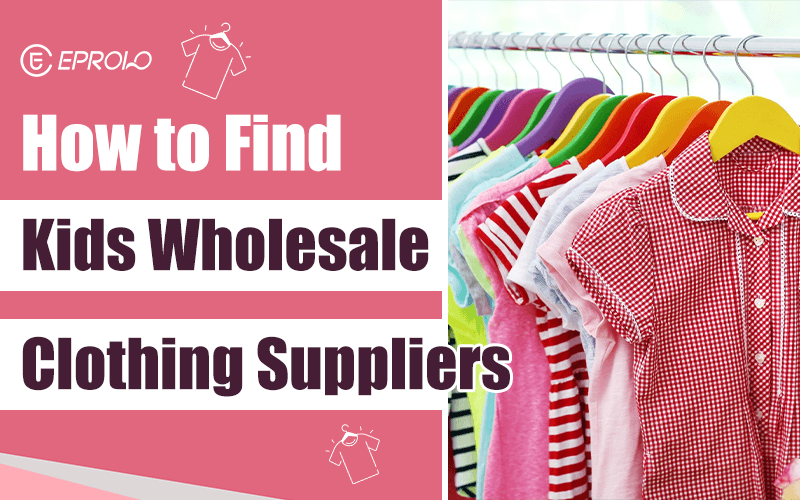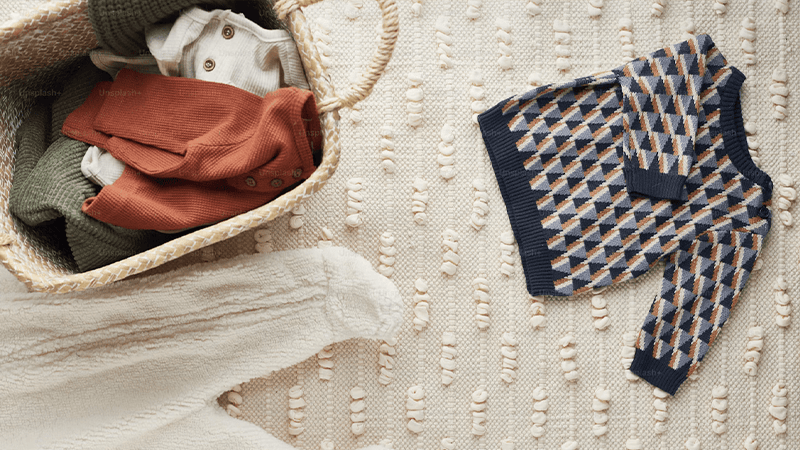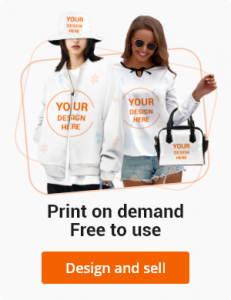Les enfants grandissent vite, mais cela ne signifie pas que les parents sont prêts à acheter des vêtements bon marché et jetables. Si vous gérez une boutique en ligne, les vêtements pour enfants peuvent représenter une catégorie à fort volume et à forte récurrence, à condition de trouver des fournisseurs offrant à la fois valeur et fiabilité.
Mais tous les grossistes ne sont pas faits pour des partenariats à long terme. Certains ne sont que des grossistes. D'autres manquent de contrôle qualité, de variété ou de transparence en matière d'expédition.
Voici comment les vendeurs de commerce électronique sérieux s'approvisionnent en vêtements pour enfants qui se vendent et fidélisent les clients.

Aperçu de la page :
01 | Découvrez ce qui se vend sur le marché des vêtements pour enfants (et ce qui ne se vend pas)
02 | Choisissez des partenaires grossistes qui comprennent réellement la mode enfantine
03 | Ne travaillez pas avec des fournisseurs qui proposent des solutions à tous les niveaux
04 | Comment EPROLO simplifie l'approvisionnement en vêtements pour enfants
05 | Les signaux d'alarme à éviter lors du choix d'un fournisseur de vêtements pour enfants
06 | Lancer petit, suivre rapidement, puis évoluer intelligemment
Conclusion : Le bon fournisseur représente la moitié de votre activité de vêtements pour enfants
FAQ : Trouver et travailler avec des fournisseurs en gros de vêtements pour enfants
01 | Découvrez ce qui se vend sur le marché des vêtements pour enfants (et ce qui ne se vend pas)
Vendre des vêtements pour enfants n'est pas la même chose que vendre des vêtements pour adultes. Les parents achètent d'abord en fonction de la fonction, puis du prix, puis du style.
Voici ce qui stimule les ventes répétées :
- Tissu doux et respirant (mélange de coton lourd)
- Durabilité (survit aux jeux violents et aux lavages)
- Des modèles qui grandissent avec l'âge (couleurs neutres, tailles ajustables)
- Ensembles abordables de 2 à 4 pièces
Éviter:
- Styles trop tendance ou flashy (datés depuis des mois)
- Matériaux exclusivement synthétiques
- Dimensionnement compliqué avec des tableaux peu clairs
Avant de chercher un fournisseur, clarifiez votre segment : basiques pour bébé, tenues décontractées pour tout-petits, ensembles assortis ou tenues saisonnières de niche (comme les tenues de vacances).
02 | Choisissez des partenaires grossistes qui comprennent réellement la mode enfantine
Vous n'achetez pas simplement des stocks : vous misez la réputation de votre magasin sur la chaîne de production d'un autre fournisseur. Votre fournisseur doit respecter trois principes :
- Approvisionnement en tissu : aucun parent ne veut de polyester qui gratte pour son tout-petit.
- Cohérence des tailles : les enfants n'essaient pas les choses, les retours vous coûtent de la marge.
- Qualité d'impression : Mauvaise sérigraphies fissure après deux lavages. Pas bien.
Les vendeurs intelligents commandent des échantillons et vérifient :
- Coutures et points d'étirement
- Boutons pression, fermetures éclair, élastiques
- Finition intérieure (pas de fils apparents)
03 | Ne travaillez pas avec des fournisseurs qui proposent des solutions à tous les niveaux
Le moyen le plus rapide de détruire votre marque ? Stocker les mêmes articles produits en série que ceux que l'on trouve sur tous les marchés bas de gamme.
Recherchez plutôt :
- Options de petits lots ou inventaire rotatif
- Ensembles avec hauts et bas assortis (plus faciles à vendre)
- Agrafes de couleur unie et graphismes doux (faible risque de retour)
- Descriptions de produits avec répartition réelle des matériaux
Conseil : associez les basiques à rotation rapide comme les barboteuses ou les t-shirts à des chapeaux ou des chaussettes : les parents aiment la commodité.

04 | Comment EPROLO simplifie l'approvisionnement en vêtements pour enfants
EPROLO n'est pas seulement un fournisseur : c'est une plateforme complète d'approvisionnement et de gestion des commandes qui vous permet de vous concentrer sur votre marque, et non sur le back-end. Pour les vendeurs de vêtements pour enfants, EPROLO propose :
- Usines vérifiées avec des catalogues spécifiques aux enfants
- Catalogue volumineux pour différents groupes (bébé, tout-petit, enfants)
- Support de marque pour l'impression de logos, d'étiquettes volantes et de sacs en polyéthylène de marque
- Synchronisation automatique avec Shopify, WooCommerce et Etsy
- Entrepôts en Chine, aux États-Unis et dans l'UE pour une livraison mondiale flexible
- Politique de retour sans questions de 7 jours pour renforcer la confiance des clients
Vous pouvez parcourir des ensembles pour tout-petits, des grenouillères de style biologique, des vêtements de détente adaptés aux enfants et des thèmes saisonniers, tous pré-vérifiés pour la qualité et la préparation logistique.
Plus important encore, EPROLO suit les performances des fournisseurs, afin que vous ne soyez pas victime d'une mauvaise exécution ou d'un dimensionnement incorrect.
05 | Les signaux d'alarme à éviter lors du choix d'un fournisseur de vêtements pour enfants
Même si le catalogue a l'air intéressant, regardez-le de plus près. Voici ce qui devrait vous inquiéter :
- Aucune décomposition de matière (il est juste écrit « mélange de coton » ? À éviter.)
- Pas de tableau des tailles ni de tailles vagues « S/M/L »
- Avis contradictoires sur le rétrécissement, la décoloration ou les odeurs
- Aucune politique de retour ou de remboursement
Évitez également tout fournisseur qui ne peut pas expliquer où et comment ses produits sont emballés et expédiés. Dans le secteur de la mode enfantine, les retards ou les dommages sont plus fréquents, surtout pour les modèles saisonniers.
06 | Lancer petit, suivre rapidement, puis évoluer intelligemment
Ne commencez pas avec plus de 100 références. Au lieu de cela :
- Lancement avec 8 à 12 articles de base (3 à 6 styles, chacun dans 2 à 3 tailles)
- Concentrez-vous sur des images de produits propres et des visuels de tailles clairs
- Surveillez de près les raisons de retour et l'abandon du panier
Utilisez ces données pour étendre vos tailles, tester des lots ou ajouter des accessoires.
Avec EPROLO, vous pouvez extraire automatiquement les données de performance de votre boutique et ajuster votre catalogue rapidement, sans dépenser trop ni surstocker.
Conclusion : Le bon fournisseur représente la moitié de vos vêtements pour enfants
Les parents achètent vite, mais ils retournent aussi vite. Chez les enfants, pas de place pour les erreurs de taille, les tissus qui grattent ou les mauvaises livraisons.
C'est pourquoi choisir le bon fournisseur n'est pas seulement une question de coût, mais aussi d'adéquation, de confiance et de cycle de vie du produit.
Avec EPROLO, vous obtenez une chaîne d'approvisionnement de vêtements pour enfants déjà testée, marquée et prête à évoluer, sans brûler votre budget en essais et erreurs.
Si vous créez une véritable marque de vêtements pour enfants, commencez avec moins de références, de meilleurs produits et un fournisseur qui comprend réellement les enjeux.
FAQ : Trouver et travailler avec des fournisseurs en gros de vêtements pour enfants
Q1. Quels types de tissus privilégier pour les vêtements pour enfants ?
Privilégiez toujours le coton ou les mélanges à dominante de coton (par exemple, 95 % coton + 5 % élasthanne). Les parents recherchent la douceur, la respirabilité et la résistance au lavage. Évitez les fournisseurs qui utilisent du 100 % polyester, sauf pour des vêtements d'extérieur résistants aux intempéries. Si une annonce mentionne simplement « mélange » sans précision, ignorez-la.
Q2. Comment puis-je m'assurer que les tailles sont exactes avant de mettre en vente des produits ?
Demandez un tableau des tailles complet avec les mesures réelles (pas seulement les étiquettes d'âge). Ensuite :
- Commandez des échantillons et mesurez chaque taille manuellement
- Comparer avec les tailles de marque standard (par exemple, Carter's, H&M Kids)
- Indiquez à la fois la « tranche d'âge » et les « mesures réelles » sur votre page produit
Soyez particulièrement prudent lorsque vous vous approvisionnez auprès de fabricants asiatiques, car leurs normes de taille diffèrent considérablement des tailles américaines et peuvent nécessiter une conversion pour la commodité de vos clients.
Un dimensionnement précis réduit les retours, en particulier pour les vêtements pour tout-petits et bébés, où même une différence de 1 à 2 cm fait une différence.
Q3. Puis-je ajouter mes propres étiquettes ou emballages de marque aux vêtements pour enfants EPROLO ?
Oui. EPROLO propose des services de branding pour les vêtements pour enfants, notamment :
- Impression du logo sur le vêtement (si des styles vierges sont utilisés)
- Étiquettes volantes, étiquettes et sacs d'emballage personnalisés
- Cartes-cadeaux personnalisées avec ruban adhésif et insert
Vous pouvez expédier ces éléments de marque à EPROLO une fois, et ils les appliqueront automatiquement à chaque commande.
Q4. Est-il préférable de s'approvisionner auprès d'entrepôts américains/européens ou en Chine pour les vêtements pour enfants ?
Cela dépend de votre public et de l’urgence :
- Entrepôt en Chine : coût de base inférieur, plus grande variété, livraison d'environ 7 à 15 jours
- Entrepôt États-Unis/UE : expédition plus rapide (environ 3 à 7 jours), idéal pour les articles urgents (par exemple, cadeaux de naissance, vacances)
Pour le dropshipping de vêtements pour enfants, commencez par la Chine. Si un produit commence à bien se vendre, recherchez des articles équivalents dans les entrepôts locaux via EPROLO pour optimiser les délais de traitement.
Q5. Avec combien de références dois-je commencer pour une collection de vêtements pour enfants ?
Commencez avec 8 à 12 références ciblées :
- 3 à 4 types de hauts (par exemple, barboteuses, t-shirts, ensembles de détente)
- 2 à 3 coloris par article
- 2 à 3 options de taille (ne listez pas la gamme complète de tailles avant d'avoir testé la demande)
Cela permet de gérer les stocks, d'améliorer la qualité des pages produits et d'identifier plus rapidement les produits gagnants. Une fois que vous savez ce qui convertit, développez vos ventes avec des offres groupées, des accessoires et des extensions saisonnières.







